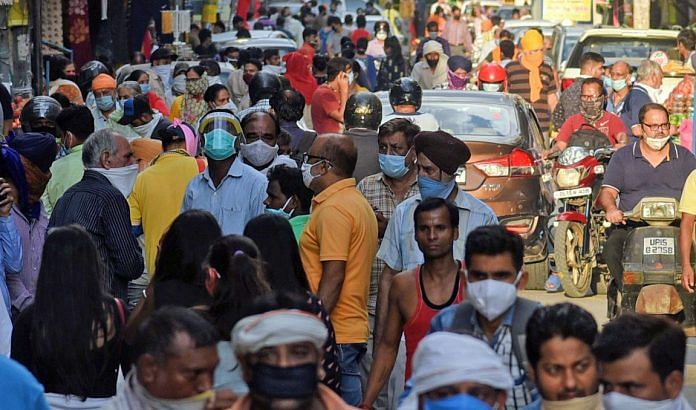New Delhi: Two weeks after Delhi Chief Minister Arvind Kejriwal promised to increase daily Covid testing, the national capital saw the numbers triple. However, the city has also seen its positivity rate go up.
Delhi government data analysed by ThePrint saw daily testing triple over the course of two weeks to 36,046 on 6 September from 11,910 on 24 August. The bulk of the increase was seen in the last week alone — to 36,046 on 6 September from 14,389 tests on 31 August.
In this period, Delhi recorded 14,389 (31 August), 24,198 (1 September), 28,835 (2 September), 32,834 (3 September), 36,219 (4 September), 38,895 (5 September) and 36,046 (6 September) daily tests.
Data on positivity rate, however, also showed a worrying rise. According to Covidtoday.in, a website run by a volunteer research group that tracks Covid cases across India, the positivity rate in Delhi increased to 8.54 per cent on 6 September from 7.28 per cent on 24 August.
On 26 August, CM Kejriwal chaired a high-level meeting to discuss the situation, and promised to increase the testing numbers to 40,000 a day within a week. Delhi was at the time testing an average of 20,000 samples a day, and had tested 19,816 samples on 26 August. Since then, while testing has increased, it has not yet touched the 40,000-mark.
The positivity rate indicates how many people test positive for the SARS-CoV-2, and indicates the spread of the Covid-19 infection. While low positivity rate implies that testing levels are sufficient, high positivity rate shows testing is not keeping up with the spread of infection. India has been aiming to keep its positivity rate below 10 per cent, and consider 5 per cent an ideal threshold.
In the last week when testing numbers significantly increased, the national capital’s positivity rate has been hovering around the 9-per cent mark. During this period, the positivity rate went from 8.7 per cent (31 August), 8.97 per cent (1 and 2 September) to 8.88 per cent (3 September), 8.84 per cent (4 September), 8.59 per cent (5 September) and 8.54 per cent (6 September).
As of 7 September, Delhi recorded a total of 1,93,526 total cases, with 4,599 deaths and 1,68,384 recoveries.
Despite the rise, Kejriwal Saturday said Delhi is in a better position than it was in June when a similar number of cases were recorded. The positivity rate was 18.54 per cent on 27 June, a day when 2,948 cases were recorded, said Kejriwal. He said the focus now is to ensure the number of deaths don’t increase.
“Time and again I have said there should be no deaths because of corona. This is the most crucial aspect of corona. On Friday, there were 2,914 cases and 13 deaths. The death count is the lowest not only across the country but across the world,” he said.
Also read: Delhi testing rate drops 5 days after CM Kejriwal promises to double it, positivity climbs
Highest single day spike in 71 days
On Sunday, Delhi recorded 3,256 cases — the highest in 71 days. The last time daily cases were above the 3,000-mark was on 26 June when 3,460 cases were recorded. On Monday, Delhi recorded 2,077 cases.
Data from the Delhi government’s health bulletins revealed that cases have tripled in the national capital in the last two weeks.
Daily cases increased to 3,256 on 6 September from 1,061 on 24 August. According to covidtoday.in, Delhi’s seven-day daily moving average (average of daily cases over 7 days) almost doubled in the last two weeks. The moving average increased to 2,579 on 6 September from 1,308 on 24 August. ThePrint had reported that Delhi has been witnessing an upward trend in daily cases after a month-long decline.
Amid the surge, Kejriwal said on 5 September there was no need to panic and that the situation was under control, attributing the spike to the increased testing.
Also read: Over 10,000 healthcare workers tested positive across 10 states, UTs since Covid struck
Localised containment, population-based surveys
Experts and doctors ThePrint spoke to said the rising cases and positivity rate in Delhi implies there is a sizable population that is yet uninfected, a theory the last sero survey findings support.
“The last sero survey showed that only 29 per cent are protected in the city. There is still a cohort of susceptible populations who will get infected as they come in contact with infected individuals. With unlock guidelines, those who were protected by staying at home earlier are now at risk,” said Dr Giridhar Babu, professor and head, Lifecourse Epidemiology, Public Health Foundation of India.
Doctors said people were likely not taking adequate precautions as the country opened up further.
“People are not taking adequate precautions like wearing masks or maintaining proper hand hygiene. What’s worrying is that with the increase in positivity rate, mortality also becomes an issue. People are going out getting infected and then coming back home and infecting the elderly or those with comorbidities,” said Dr Anant Bhan, a researcher in global health and bioethics.
Apart from targeted testing to include high risk contacts and those with Covid symptoms, population-based surveys must also be conducted, said Babu. “Delhi should focus on population-based surveys to determine symptoms along with testing, tracking and treating. Strict implementation of precautionary measures like masks, social distancing should accompany avoiding crowds and closed spaces,” he added.
Strategy of testing and localised containment must still be an important focus, said Bhan. “Instead of statewide or nationwide lockdowns, localised containment zones and an eye on the numbers will enable faster response,” he added.
Also read: Rising Covid cases fill up ventilator beds, but here’s why doctors say Delhi needn’t worry yet






